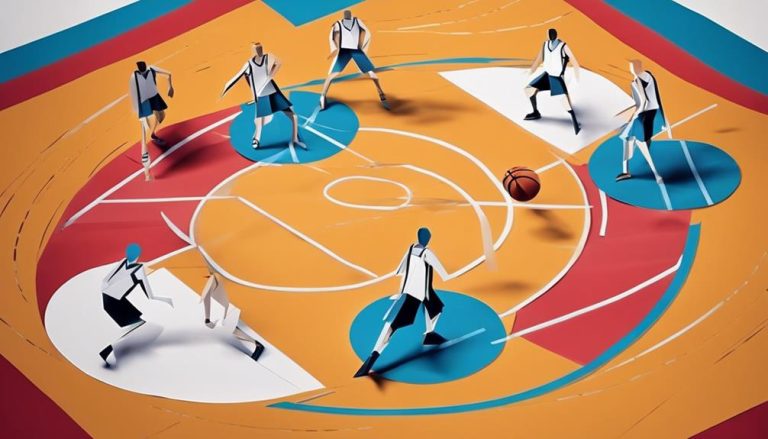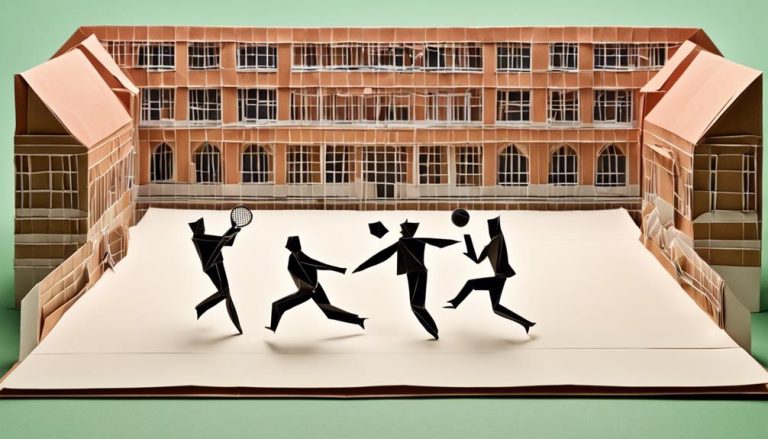General Rules of Indoor Soccer
If you're into indoor soccer, here's what you need to know. The field is rectangular, around 200 feet long and 85 feet wide. Teams usually have 5 players who switch positions. Substitutions keep players fresh and can alter game dynamics. Matches have two halves lasting 20-25 minutes each. Goalkeepers play a key role, especially in penalty areas. Scoring occurs from penalty kicks, corners, and set pieces. Scoring goals requires offensive teamwork and defensive strategies. Penalties can decide tied matches with overtime and shootout options. Curious about more indoor soccer rules? Keep exploring the game nuances.
Field Dimensions
When setting up for an indoor soccer game, make sure to take note of the field dimensions. The field should be rectangular, with dimensions typically around 200 feet in length and 85 feet in width. It is important to verify that the field meets these requirements to maintain a fair and competitive game environment.
In terms of equipment requirements, indoor soccer necessitates non-marking rubber-soled shoes to protect the playing surface. Safety guidelines should be followed, such as avoiding rough play and making certain that all players are wearing appropriate gear to prevent injuries.
Field maintenance is vital for a smooth game. Keep the playing surface clean and free of debris to prevent accidents and ensure the ball rolls smoothly. Additionally, game strategies play a significant role in indoor soccer. Due to the confined space, quick passes, constant movement, and good communication are key components for success. Understanding these strategies can give your team an edge during the game.
Team Composition
Alright, ready to learn about the key points of team composition in indoor soccer? You'll want to understand player positions and the substitution rules to make sure your team is set up for success on the field. Let's break down these essential aspects to help you navigate the dynamics of indoor soccer play.
Player Positions
Understanding the strategic player positions, also known as team composition, is essential in indoor soccer to optimize performance on the field. Defensive strategies and offensive tactics play a critical role in determining player roles and formation adjustments. In indoor soccer, player positions are more fluid compared to outdoor soccer due to the smaller playing area. Typically, teams consist of five players, including a goalkeeper. The positions are versatile, with players often switching between offensive and defensive duties based on the flow of the game. Defenders need to be agile and strong in one-on-one situations, while forwards must possess speed and accuracy in front of the goal. Midfielders act as the link between defense and offense, requiring excellent passing and decision-making skills. Mastering these roles is key to success in indoor soccer.
Substitution Rules
To enhance team dynamics and maintain player endurance during an indoor soccer match, understanding the substitution rules is essential. Player rotation and bench strategy play vital roles in keeping the team fresh and competitive throughout the game. Here's a simple breakdown to help you optimize your substitutions:
| Strategy | Description |
|---|---|
| Player Rotation | Regularly swapping players from the field to the bench to prevent fatigue. |
| Impact Substitutions | Bringing in key players during critical moments to change the game's momentum. |
| Tactical Changes | Adjusting the team's formation or style by substituting players strategically. |
Duration of Play
When playing indoor soccer, the duration of each match typically consists of two halves. Each half usually lasts around 20-25 minutes, depending on the league or competition rules. Here are some essential points to keep in mind regarding the duration of play:
- Half Time Break: After the first half, there is a brief break, usually lasting around 5-10 minutes. This break allows players to rest, rehydrate, and receive any necessary coaching instructions.
- Overtime Periods: If the match ends in a tie, some indoor soccer leagues may have overtime periods to determine a winner. Overtime periods are typically shorter than regular halves, lasting around 5-10 minutes each.
- Stoppage Time: Just like in outdoor soccer, indoor matches may also have added time at the end of each half for any stoppages that occurred during play. The referee keeps track of this additional time and decides when to end the half.
- Running Clock: Unlike outdoor soccer, indoor soccer often features a running clock, which means the time does not stop for stoppages. This continuous clock adds a fast-paced and intense element to the game, requiring players to stay alert and focused throughout the match.
Understanding the duration of play in indoor soccer is essential for players and spectators alike to fully enjoy the game and appreciate its unique dynamics.
Ball in Play
After the duration of play has been established in indoor soccer, the focus shifts to keeping the ball in play efficiently to maintain the game's fluidity and momentum. Goalkeepers play an important role in ball control. They are the only players allowed to use their hands and arms to play the ball within the penalty area. Beyond their penalty area, they must follow the same rules as outfield players, using their feet to control the ball. This dynamic adds an element of strategy and quick thinking to the game, as goalkeepers must decide when to use their hands or feet to keep the ball in play.
Corner kicks and set pieces are significant opportunities to score in indoor soccer. During a corner kick, the ball is placed inside a marked semi-circle at the corner of the field, and the attacking team has a chance to shoot directly at the goal. Defending teams often use these moments to swiftly shift to offense, making corner kicks an important aspect of ball control and game momentum. Set pieces, like free kicks or penalty kicks, also require precise ball control to capitalize on scoring chances.
Substitutions
Substitutions in indoor soccer provide teams with the strategic advantage of revitalizing players and adjusting tactics during the course of the game. This essential aspect of the game can greatly impact player rotation and team dynamics, influencing player morale and overall performance.
Here are four key points to contemplate about substitutions in indoor soccer:
- Player Rotation: Substitutions allow coaches to manage player fatigue effectively, ensuring that fresh legs are on the field when needed most. By rotating players strategically, teams can maintain a high level of intensity throughout the game, increasing their chances of success.
- Tactical Adjustments: Substitutions also offer teams the opportunity to modify their playing style and tactics based on the flow of the game. Whether it's adding a more defensive player to protect a lead or introducing an attacking threat to break a deadlock, substitutions play a pivotal role in shaping the outcome of the match.
- Bench Dynamics: How substitutions are managed can impact the morale and cohesion of the team. Keeping players engaged and involved, even when on the bench, is critical for maintaining a positive team atmosphere and fostering a sense of unity.
- Strategic Timing: Knowing when to make substitutions is an art form in itself. Coaches must assess the situation on the field, anticipate the needs of the team, and make decisive changes at the right moment to maximize their effectiveness.
Fouls and Misconduct
Understanding fouls and misconduct is vital in indoor soccer as they directly impact the flow and fairness of the game. In indoor soccer, fouls are penalized by free kicks, penalty kicks, or even cards. When a player commits a foul, the referee makes decisions based on the severity of the offense.
Fouls can range from minor infractions like a slight push to more serious offenses such as tripping an opponent. Referees use their judgment to maintain fair play and safeguard the safety of all players on the field. They may choose to give a verbal warning, award a free kick to the opposing team, or even show a yellow or red card.
Yellow cards are a caution, signaling a warning to the player. If a player receives two yellow cards in the same game, it results in a red card, leading to ejection from the match. A red card is a serious consequence, usually given for violent conduct or repeated offenses. It forces the team to play with one player short for the remainder of the game.
Penalty kicks are awarded for more severe fouls committed inside the penalty area. This gives the opposing team a direct shot on goal from a designated spot, providing a significant scoring opportunity. Understanding the rules surrounding fouls and misconduct is essential for players to maintain good sportsmanship and contribute to an enjoyable indoor soccer experience.
Scoring and Winning
When it comes to scoring in indoor soccer, remember that goals are the key to victory. But what happens when the game ends in a tie? That's when tiebreaker rules come into play to determine the final outcome.
Goals for Victory
To secure victory in indoor soccer, scoring goals effectively is essential. Here are some key points to help you achieve success:
- Offensive strategies: Employ tactics like passing, dribbling, and teamwork to create scoring opportunities.
- Defensive tactics: Focus on marking opponents, intercepting passes, and regaining possession quickly to prevent the opposing team from scoring.
- Goalkeeper responsibilities: The goalkeeper must have quick reflexes, good positioning, and effective communication with the defense to stop shots on goal.
- Shooting techniques: Work on accuracy, power, and placement when taking shots to increase the chances of scoring and securing victory.
Mastering these aspects of the game will definitely elevate your indoor soccer performance.
Tiebreaker Rules
For a clear understanding of how tiebreaker rules impact scoring and winning in indoor soccer, let's explore the specifics. In indoor soccer, if a match ends in a tie during regular play, overtime procedures come into play. Overtime typically consists of two five-minute periods. If the tie persists after overtime, some leagues may proceed to a penalty shootout. During a penalty shootout, each team nominates players to take penalty shots against the opposing team's goalkeeper. The team with the most goals at the end of the shootout is declared the winner. Penalty shootouts are a thrilling way to determine the victor in a tied match, adding an element of excitement and suspense for both players and spectators.
Frequently Asked Questions
Can Players Wear Cleats or Turf Shoes on the Indoor Soccer Field?
You can wear either cleats or turf shoes on the indoor soccer field. Make sure to take into account safety concerns such as traction and potential for injury. Choose the footwear that gives you the best grip and agility.
Are There Any Restrictions on How High Players Can Kick the Ball Indoors?
When playing indoor soccer, there are no specific restrictions on how high you can kick the ball. However, focusing on ball control and shot accuracy is key to mastering the game and scoring goals effectively.
Is There a Limit to the Number of Players a Team Can Have on Their Roster for Indoor Soccer?
You're wondering about roster limits in indoor soccer. Well, typically, there's a maximum number of players allowed on a team's roster. Substitution rules also come into play, ensuring fair play and keeping things dynamic.
Are There Specific Rules Regarding the Goalkeeper's Positioning and Movements in Indoor Soccer?
As the goalkeeper in indoor soccer, your responsibilities include strategic positioning and agile movements. Coordinate with defenders through clear communication to maintain a strong defense. Your role is pivotal in protecting the goal.
How Are Ties Handled in Indoor Soccer Games?
In indoor soccer, ties are resolved through overtime rules that include a shootout procedure. Referees make decisions based on fair play considerations to determine the winner. Stay engaged as the game may intensify in these moments.
Conclusion
So, now that you know the general rules of indoor soccer, you're ready to hit the field and show off your skills. But wait, you might be thinking that it's too much to remember all these rules. Don't worry, with practice and experience, these rules will become second nature to you. Just focus on having fun and improving your game, and before you know it, you'll be dominating the indoor soccer scene.






